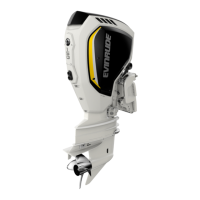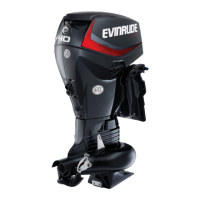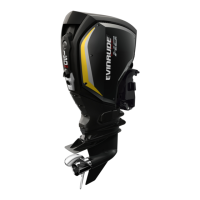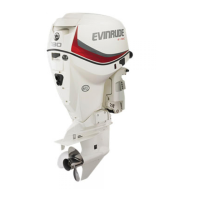16
BOAT RIGGING
BATTERY INSTALLATION
Battery Cable Requirements
Evinrude outbo ards are shippe d with stranded
copper bat tery ca bles for typical inst allations in
which the starting battery is close to the transom.
Specialized outb oard inst allations with e xtended
length ba ttery cable s require an increased wire
size. Refer to the following table.
IMPORTANT: Inadequate ba ttery cables can
affect the performance of an outb oard’s high
amperage start circuit and th e cranking speed of
the outboard. DO NOT use aluminum wire cables.
Use ONLY AWG stranded copper wire cables.
Battery Switches and Multiple
Batteries
A multiple battery setup, including marine batte ry
selector switches, can provide fle xibility i n sing le
and dual outboard installations.
Refer to Battery and Switch Wiring Diagrams
on p. 18 for battery connection options.
The battery selection function can be used for
emergency starting if a primary bat tery becomes
discharged.
The OFF po sition o f the batte ry sele ctor switch
can be used to minimize battery discharge during
periods of non-use.
Typical battery functions
Primary
• Used as starting battery under normal operating
conditions.
• Red (+) cable connected to battery switch.
• Primary battery is charge d by conne ction to
main red (+) outboard battery cable.
Dual outbo ard installations can utilize the oppos-
ing outboard's primary battery as a secondary bat-
tery for emergency starting only.
Secondary
• Used as back-up starting batter y un der abn or-
mal operating conditions.
• Red (+) cable connected to battery switch.
• Secondary b attery is charged independently
from primary battery.
Accessory
• Not used as starting battery.
• Isolated from outboard start function.
• No red (+) cable connected to battery switch.
Secondary and accessory batte ries are often
charged by an iso lated batte ry ch arging circuit.
Refer to Auxiliary Battery Charging on p. 17.
Battery Switch Requirements
Battery switches must meet the following require-
ments.
• The switch must be approved for marine use.
• The switch sh ould be a “make before break”
design.
• Switch amperage rating should be adequate for
the outboard it will be used on.
• Use one batt ery switch for each outboa rd
installed.
• Use appropriately sized wire and terminals.
• Use AWG stranded copper wire.
Battery Switch Location
•
Locate battery switch as close t o the bat teries
as possible.
• Locate swit ch so that it cannot be accid ently
bumped or switched.
• Refer to the battery switch manufacturer’s
installation instructions.
• Fasten all battery switches to solid surfaces.
• Route wiring as directly as possible.
• Support the battery switch as needed to prevent
abrasion.
• Use appropriate wiring and connectors.
• Seal all connections an d te rminals with liquid
neoprene to prevent corrosion.
Insulate all battery positive (+) ter-
minals to prevent shorting.
15–30 HP 40–300 HP
1 to 10 Ft.
(.3 to 3 m)
6 Gauge 4 Gauge
11 to 15 Ft.
(3.4 to 4.6 m)
4 Gauge 2 Gauge
16 to 20 Ft.
(4.9 to 6.1 m)
2 Gauge 1 Gauge
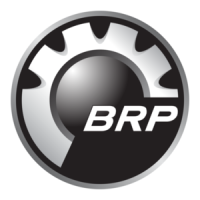
